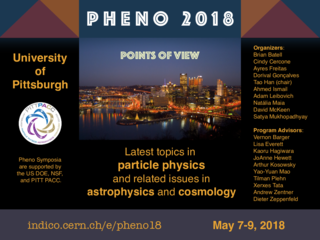Phase transitions in the early universe can readily create an observable stochastic gravitational wave background. I will argue that such a background necessarily contains anisotropies analogous to those of the cosmic microwave background (CMB) of photons, and that these too may be within reach of proposed gravitational wave detectors. Correlations within the gravitational wave anisotropies...
We have studied the generation of gravitational waves by magnetohydrodynamic turbulence during the Electroweak Phase Transtion (EWPT).
We use direct numerical simulations (DNS) of decaying and forced hydromagnetic turbulence during the EWPT. For that purpose, we use the Pencil Code (https://github.com/pencil-code), an open source code that allows to solve sets of partial differential...
Dark matter (DM) that implodes neutron stars (NSs) may explain the paucity of pulsars in the Milky Way galactic center, the source of r-process elements, and the origin of fast-radio bursts. We identify new astrophysical signatures of NS-imploding DM, which could decisively test these hypotheses in the next few years.
The use of distribution of NS mergers in the galaxies, in particular, will...
Observations of gravitational waves from neutron star mergers offer the first access to possible vacuum energy contributions of new QCD phases at large densities. Measurements of this sort have the potential to turn neutron stars into laboratories for fundamental physics: they can provide a new test of the gravitational properties of vacuum energy, and determine the size of the QCD...
Among cosmological relaxation solutions to the weak-scale hierarchy problem, gauge boson production is a particularly efficient backreaction mechanism for trapping the relaxion. In these models, scanning can even happen after inflation and the relaxion field range can be sub-Planckian, with no extremely small parameters or large e-foldings involved. We consider a model where particle...
In this talk, we will discuss how the dimension-six operators change the rate of baryon number violation rate via sphaleron transition. Applying Newton-Kantorovich method, we solve related nonlinear sphaleron equations numerically. Depending on the sign of the coefficients of the dimension-six operators, the sphaleron energy will increases or decreases. Since the coefficient of these...
Quantum fields living on cosmological spacetimes can experience particle production due to their interaction with the expanding background. Given the right conditions, the energy density of the particles produced through this process can become pronounced enough to backreact on the cosmological expansion. In this work we review the basics of cosmological quantum particle production through the...
Inspired by the Contino-Pomarol-Rattazzi mechanism we explore scenarios with a very light (100 keV to 10 GeV) radion which could be associated with the suppression of the electroweak contribution to vacuum energy. We construct explicit, realistic models that realize this mechanism and explore the phenomenological constraints on this class of models. Compared with axion-like particles in this...

